Why the need of a trained squint specialist: Ocular motility problems are complex. To understand their true mechanics and to offer best therapy to such patients, a Trained Strabismomlogist (squint specialist) is necessary. Eye muscles are very delicate structures and best surgical results can only be obtained by a First Time Surgery.
Only a trained squint specialist can not only straighten the eyes in one sitting but also ensure that they stay aligned throughout the life of that patient.
The following problems need the expertise of a trained Strabismologist:
- Refractive Errors: myopia, hypermetropia, astigmatism
- Amblyopia: at any age.
- Esotropia (Inturning of eyes)
- Paralysis of any ocular muscleExotropia (Outwards turning of eyes)
- Duane’s Retraction Syndrome
Eye Conditions

Entropion of upper or lower eyelids:
Inversion or inturning of the eyelid margin with secondary misdirection of eyelashes towards the globe causes progressive irritation of the eye. It results in constant watering and rednes
s of the eye. The sharp, misdirected eyelashes may damage the cornea as well and impair the sight considerably. This needs to be treated surgically. Read more…
Misdirected eyelashes (Trichiasis / Distichiasis):
A few misdirected eyelashes also cause considerable ocular discomfort. New laser therapy by Plasma Fugo Blade can get rid of these permanently in no time. Read More…
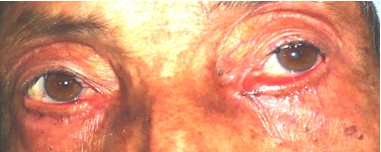
Ectropion:
Outward turning of the lid margin results in constant watering from the eye and secondary thickening and scarring of the lower lid skin. This not only looks unsightly but constant trickling down of tears is unaesthetic as well. This is also corrected surgically. Read more…

Facial Palsy:
It always affects one side of face. The face will feel stiff or pulled to one side, and may look different. There is a flattening of the affected half of the face, with loss of the forehead wrinkles and horizontal lines, a droopy eyebrow. Difficulty in closing the eye, an inability to whistle and the corner of the mouth pulled down. Difficulty in eating and drinking; food falls out of one side of the mouth. Drooling, due to lack of control over muscles of the face. Problems in smiling, grimacing, or making facial expressions. Read more….
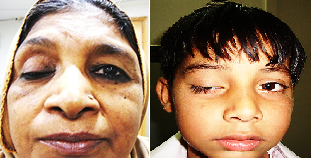
Ptosis:
A droopy upper lid is a very common clinical condition. The eyelids are elevated by the contraction of upper eyelid muscles. They are either weak by birth resulting in ptosis in a newborn or they get weakened in old age. This results in difficulty in seeing with that eye. Its treatment is surgical correction. Read more…
Watering Eyes
Excessive tearing and their overflowing down the cheek is called epiphora. This can have many different causes. A careful clinical examination is performed to determine the underlying cause. Treatment will depend on the cause. Read more…
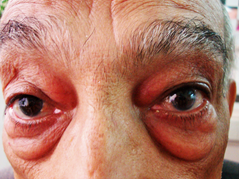
Blepharoplasty:
Loose hanging skin over the upper lids or below the lower lids occurs as a part of normal ageing process. Such changes in the eyelid appearance convey an inappropriate message of tiredness, sadness, and absence of vigor, which may diminish the aesthetic appearance of the face. This needs excision of the extra skin and the prolapsed fat. Read more…
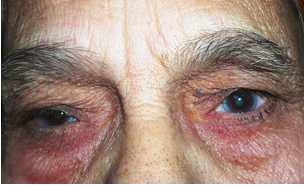
Brow Droop:
With age, the brows may droop downwards and the extra weight of the overhanging skin of the upper eyelids causes eyelashes to turn inwards and a false appearance of drooping of the upper lids too. All these problems are exaggerated in facial palsy. Read more…
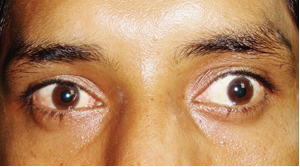
Upper Lid Retraction:
This may occur in Thyroid eye disease due to excess production of thyroid hormones in the body resulting in a staring appearance. This needs a correct diagnosis and appropriate management either by medicines or surgically. Read more…
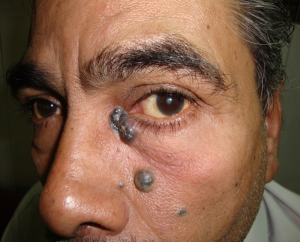
Eyelid Tumors:
Numerous kinds of cysts and tumors may appear on the eyelids. They could either be benign or malignant. They need appropriate diagnosis and surgical excision without damaging the delicate lid structures and proper appearance of the eyelids. Read more…
Dark Circles
In the lower eyelid a weakening of the supporting tissues, and in the cheek area (the mid-face) a loss of soft tissue, tend to highlight the appearance of the bony rim of the eye socket which lies between the lower eyelid and the cheek. Read more…
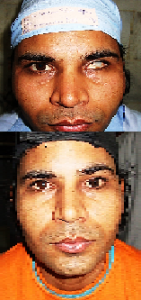
Loss of an Eye & its Replacement Surgery:
For Tumor inside the eyeball, the eye has to be removed, enucleated and replaced by an Orbital Implant to give patient an artificial eye and an acceptable cosmetic appearance. Similarly, following extensive trauma and irreparable damage to the eyeball, a small, shrunken eye that has lost all vision, is removed and replaced by an artificial eye which is cosmetically appealing to the patient. Loss of an eye causes a lot of psychological trauma to the patient; a nearly normal looking artificial eye gives hope and a new outlook on life. Read more…
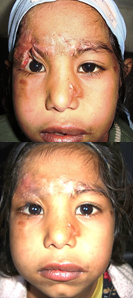
Traauma & eyelid reconstruction:
Following injuries to the face and eyelids, proper restoration of eyelid structures is very important to obtain perfectly functioning eyelids as well as a perfect cosmetic appearance. This can only be achieved by an oculoplastic surgeon especially trained in this skill. Read more…

